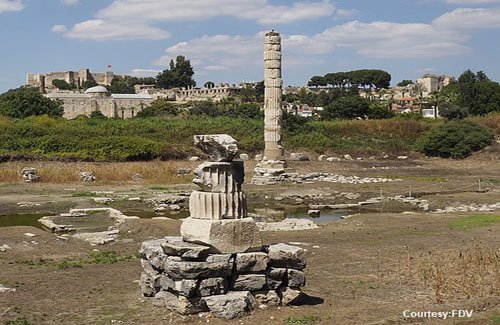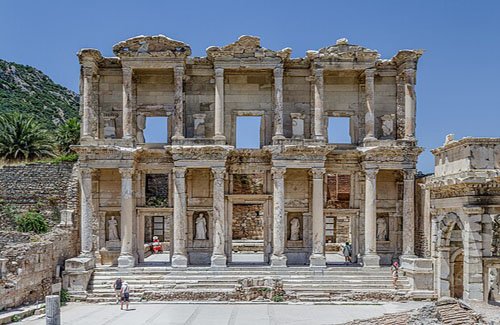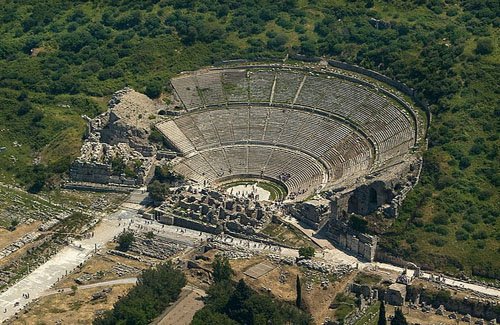Ephesus (Selçuk): A Journey Through Antiquity's Grandiose City
Ephesus, nestled near modern-day Selçuk in Turkey, isn’t just an archaeological site; it’s a portal to a bygone era. Here, we unveil the detailed story of this magnificent ancient Greek city, its rich history, and the captivating conversations its ruins inspire.
A City Steeped in Myth and History:
10th Century BC – Birth of a City: Legend attributes the founding of Ephesus to an Amazon queen. Historical evidence suggests the city flourished around the 10th century BC, becoming a major center for trade and culture.
Roman Dominion (133 BC): Ephesus reached its zenith under Roman rule from 133 BC onwards. Imagine the city bustling with commerce, grand temples rising, and philosophers like Heraclitus contemplating life’s mysteries within its walls.
Temple of Artemis (One of the Seven Wonders): Completed around 550 BC, this magnificent temple dedicated to the Greek goddess Artemis was one of the Seven Wonders of the Ancient World. Picture conversations about the awe-inspiring structure, its intricate details, and the religious significance it held.

Library of Celsus (2nd Century AD): This stunning facade, built in the 2nd century AD, served as a monumental entrance to a vast library. Imagine scholars poring over scrolls, students debating philosophical ideas, and the intellectual energy that permeated this center of learning.

The Rise of Christianity: Ephesus played a significant role in the early spread of Christianity. The apostle Paul resided here for several years, and the city housed one of the Seven Churches of Asia mentioned in the Book of Revelation.
Conversations Through the Stones:
Echoes of Trade and Commerce: Ephesus thrived as a major commercial hub. Imagine conversations about bustling marketplaces, the exchange of goods from across the Roman Empire, and the haggling of merchants.
A Stage for Spectacles: The city’s magnificent Great Theater, with a seating capacity of 25,000, hosted plays, athletic contests, and even gladiatorial combats. Consider conversations about the roar of the crowd, the thrill of the games, and the entertainment that captivated audiences.

A Microcosm of the Ancient World: Ephesus was a melting pot of cultures, with influences from Greece, Rome, and the East. Spark conversations about the blend of architectural styles, religious beliefs, and artistic expressions that co-existed within the city.
A Legacy That Endures:
Though largely in ruins today, Ephesus continues to capture our imagination. It’s a place where history comes alive, prompting conversations about human achievement, the rise and fall of civilizations, and the enduring legacy of the ancient world.
Conclusion:
Step into the remnants of Ephesus and embark on a journey through time. It’s a place that ignites the imagination, fostering conversations about commerce, culture, and the enduring power of human civilization.
Mount Nemrut: A Crown of Statues Gazing at Eternity
Atop the southeastern Anatolian mountains lies Mount Nemrut, a place where history and mystery converge. Here, colossal statues stare out at the horizon, whispering tales of a forgotten kingdom. Craft a captivating post for your website with this detailed story:
A King’s Astronomical Legacy (1st Century BC):
62 BC – The Rise of Antiochus: Around 62 BC, King Antiochus I Theos of Commagene ascended the throne. Imagine an ambitious ruler seeking to leave a lasting mark.
A Tomb for the Gods (c. 62-49 BC): Antiochus embarked on an ambitious project – the construction of a unique tomb complex on Mount Nemrut. Envision the challenges of hauling massive stones up the mountainside.
The East Meets the West: The statues lining the eastern and western terraces depict a blend of Greek, Armenian, and Persian deities. Spark conversations about the fascinating fusion of artistic styles and religious beliefs.

A Legacy of Questions: The exact purpose of the tomb complex and the reasons behind some of the iconography remain shrouded in mystery. Consider posing questions to ignite user curiosity: Who were these enigmatic gods? What rituals might have taken place here?
Conversations Among the Clouds:
A King’s Divine Decree: Antiochus sought to be recognized as a god amongst the deities depicted in the statues. Imagine conversations about his ambition, his desire for immortality, and the lengths he went to achieve it.
Astronomical Alignments: The statues were positioned with astronomical precision. Consider conversations about the possible connection between the celestial bodies and the rituals or beliefs practiced at the site.
Lost to Time, Rediscovered by Chance: The tomb complex lay hidden for centuries, rediscovered in the late 19th century by German archaeologists. Imagine the awe and wonder of these explorers stumbling upon this forgotten marvel.
A Beacon Through the Ages:
Despite the unanswered questions, Mount Nemrut stands as a testament to human ambition and artistic achievement. It’s a place that ignites the imagination and sparks conversations about history, astronomy, and the enduring desire to conquer mortality.
Conclusion:
Embark on a captivating journey to Mount Nemrut. Witness the colossal statues, ponder the mysteries they hold, and feel the touch of history amidst the breathtaking mountain vistas.
Pamukkale: A Dreamy Landscape Carved by Nature's Hand
Pamukkale, also known as “Cotton Castle” in Turkish (Pamuk = cotton, Kale = castle), is a natural wonder unlike any other in Turkey. Here, we’ll delve into the story of this breathtaking landscape, its history, and the captivating conversations it evokes:
A Geological Marvel Takes Shape (Over Thousands of Years):
Millennia in the Making: Pamukkale’s otherworldly beauty is the result of millennia of geological processes. Calcium-rich thermal waters cascaded down the mountainside for centuries, creating the travertine terraces we see today. Imagine the slow and steady hand of nature sculpting this awe-inspiring formation.

Hierapolis (190 BC): While the thermal springs likely attracted visitors for millennia, the ancient city of Hierapolis was established around 190 BC. Imagine a bustling Greco-Roman city built around these natural wonders.
Roman Ingenuity: The Romans harnessed the hot springs, channeling the water to create elaborate bath complexes and fountains within Hierapolis. Consider conversations about the ingenuity of Roman engineers in utilizing the natural resources for leisure and wellness.
A UNESCO World Heritage Site (1988): In recognition of its unique geological formations and historical significance, Pamukkale was designated a UNESCO World Heritage Site in 1988.
Conversations Inspired by the Cottony Canvas:
A Paradise for Healing: The hot springs of Pamukkale were believed to have therapeutic properties, attracting visitors seeking cures for various ailments. Spark conversations about the historical perception of these waters and their place in ancient medicine.
A Fragile Beauty: Pamukkale’s delicate ecosystem is susceptible to damage from human activity. Consider including discussions about conservation efforts to ensure the preservation of this natural wonder for future generations.
Walking on Clouds: The travertine terraces, once a popular spot for bathing, are now protected walkways. Imagine conversations about the unique sensation of walking on this soft, white surface, feeling like you’re traversing a dreamscape.
A Timeless Enchantment:
Pamukkale’s ethereal beauty continues to captivate visitors from around the world. It’s a place where nature’s artistry unfolds, prompting conversations about history, healing, and the delicate balance of our environment.
Conclusion:
Immerse yourself in the surreal beauty of Pamukkale. Stroll along the pristine white terraces, marvel at the ancient ruins, and appreciate the enduring power of nature’s artistry.
References: Own Research, Wikipedia
Related Post: Jordan’s Gems:Historical Mosques and Places
Also Read: Exploring Egypt’s Mosques
May You Like: Makkah : Holy Sites and History

